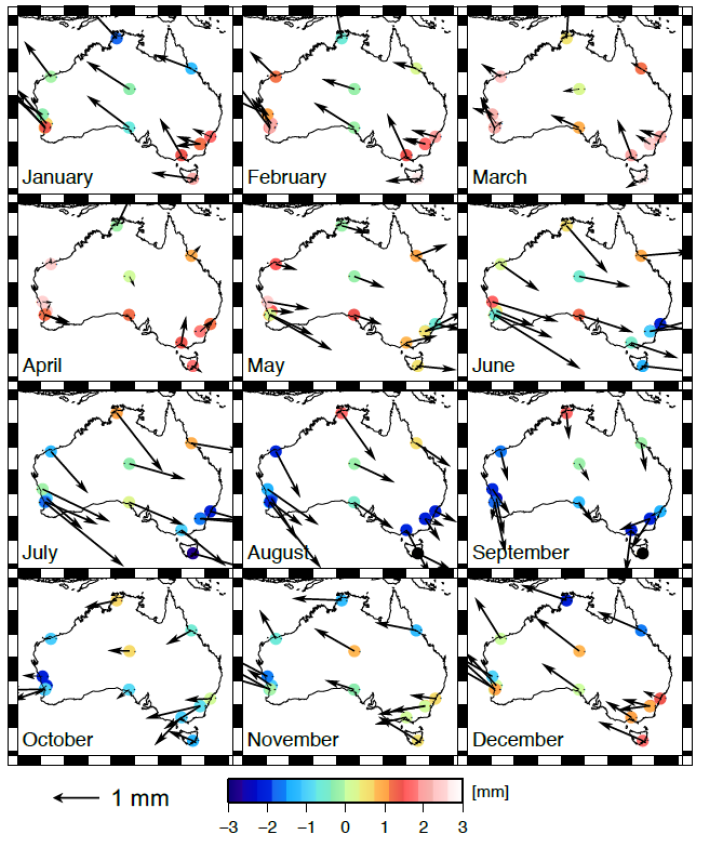Australia Moves Millimeters In Tune With the Seasons
A new study shows how far-off weather patterns affect the continent down under
/https://tf-cmsv2-smithsonianmag-media.s3.amazonaws.com/filer/15/fc/15fcb216-9505-4e35-9a2e-c01c91d1178b/australia_satellite_plane.jpg)
What makes continents move? Geologists have long sought answers within Earth's mantle. The concept is simple: Tectonic plates rest on top of the asthenosphere in Earth’s upper mantle. The asthenosphere is like a conveyor belt with convection currents of molten rock that shift the tectonic plates as the mantle flows and shifts.
But Australia moves at a surprisingly fast rate—it's shifted 4.9 feet since 1994. Not only does the continent shift over time, but it also wiggles back and forth in the ocean. And a new study published recently in the Journal of Geophysical Research suggests that the seasons may be to blame.
Shin-Chan Han, author of the study and geodesy researcher at the University of Newcastle, happed upon this connection while playing around with GPS data gathered from land-based stations. When he combined those measurement with data from NASA’s Gravity Recovery and Climate Experiment (GRACE) satellites, a seasonal pattern emerged. During the summer, the continent shifts northwest, and during winter it shifts southeast.
“This motion is related to global climate,” he tells Smithsonian.com. He uses an imaginary ball full of air to explain. If you pushed your finger down on the area where Europe might be on a globe-like ball—similar to how ice and air pressure bear down on the continent during winter—Europe itself wouldn’t shift much, but the rest of the ball would expand to make up for the pressed-in spot. As a result, continents like Australia would shift. “Europe does not change much due to the loading under Europe, but Australia shifts toward Europe,” he says.

He explains that the weight from increases in rain, ice, snow and atmospheric pressure moves around in tune with the seasons. “[During] Northern winter, the heaviest area is in Europe. In Northern summer, the heaviest area is in the Southern Pacific.”
The result is detectable as far away as Australia, as the continent shifts in response to far-away seasons. Since Australia is right between Europe and the South Pacific, it experiences the effects of all of that water and atmospheric pressure more prominently than other continents.
Han took the concept one step further, using the seasonal shifts of Australia to calculate how Earth’s center of mass moves around. Because Australia moves along with the planet's center of mass, scientists can use data about the continent's seasonal motion to help make measurements more precise.
“You’re lost if don’t know the relationship between ground data and satellite data,” he says. “You’re wrong if you don’t understand the motion of Earth’s center.”
It may seem as if a few millimeters don’t matter, but when it comes to precision instruments that measure things like ocean levels, those small movements can lead to big mistakes. Better measurements will lead to better precision with instruments that rely on systems such as GPS. There’s another benefit: A better understanding of how Australia and other continents' shift will give scientists a baseline they can use to study the effects of a changing climate on Earth’s motion. And as Han points out, it’s a great reminder that the ground beneath us is anything but stable.
“We’re really living on a restless planet,” he says. Turns out there’s no such thing as solid ground—but with the help of methods like Han’s, scientists could come closer to a solid understanding of how Earth rocks and rolls.
/https://tf-cmsv2-smithsonianmag-media.s3.amazonaws.com/accounts/headshot/erin.png)
/https://tf-cmsv2-smithsonianmag-media.s3.amazonaws.com/accounts/headshot/erin.png)